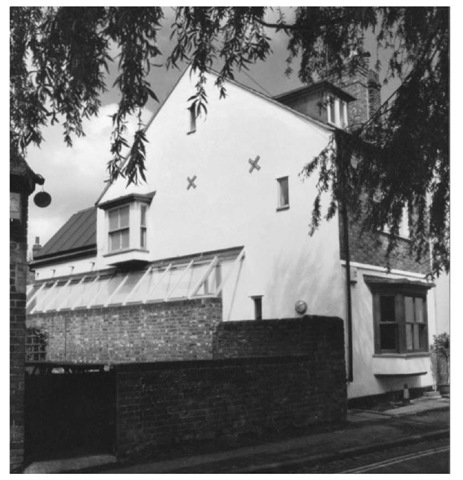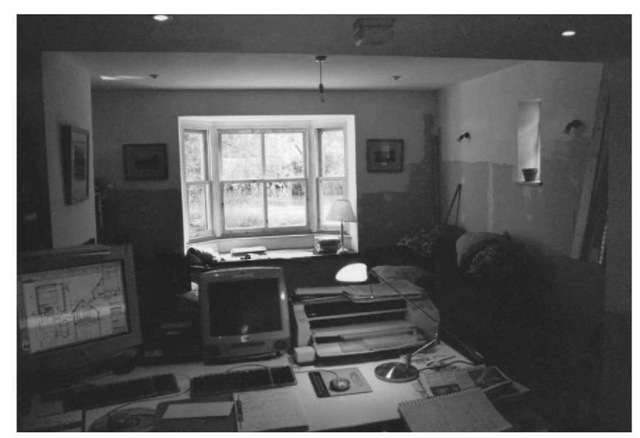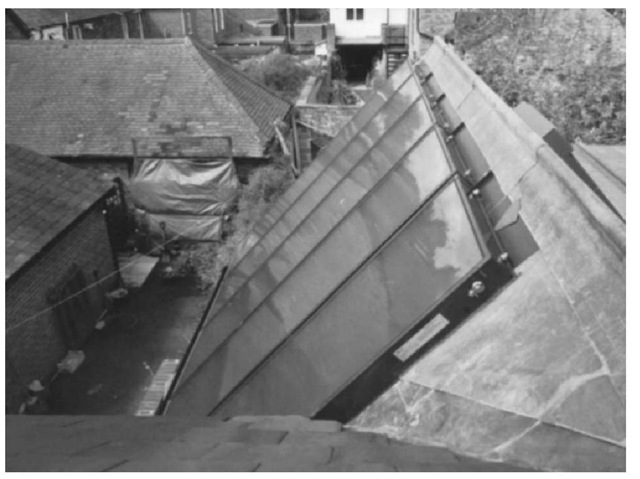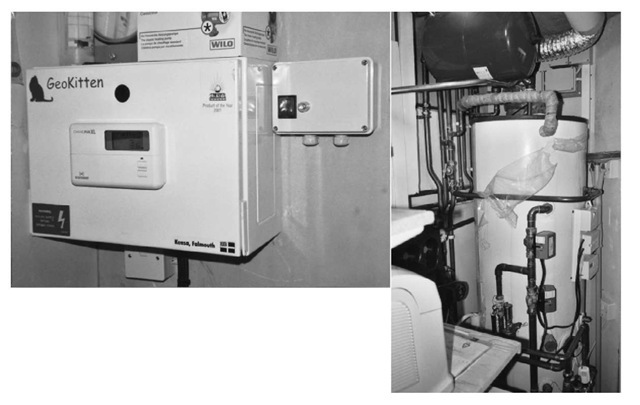Osney Island is a quiet enclave Conservation Area in a corner of Oxford on the banks of the River Thames. A small, end of terrace house facing the river is a remarkable example of a comprehensive eco-upgrading of a 19th century property. Its owner, David Hammond, is an architect who has been committed to environmental concerns since before his graduation (Figure A.1).
Figure A.1 End of terrace house in Osney Island, Oxford, UK, showing the sun space created out of the side access passage. This will be the site for future photovoltaic cells.
Figure A.2 Ground floor showing dry lining during installation.
There follows a brief summary of the eco-refurbishment that has been carried out by David.
In the first place, the house has been comprehensively insulated internally. All directly exposed external walls have been battened out with between 75 mm and 125 mm Rockwool RWA 45 insulation, behind Fermacell dry lining (Figure A.2).
A rear timber frame extension has been added, insulated with 100 mm of Rockwool between the framing and 50 mm Kingspan insulation across the framing internally. The loft space has been utilized as bedrooms with insulation following the profile of the roof.
The second major feature of the refurbishment process is the production of solar thermal energy via flat bed solar collectors.
The south-facing roof of the ground floor extension is devoted to supporting five solar panels: 7.5 m2 Viessmann flat bed collectors (Figure A.3). These contribute hot water, at temperatures up to 65° C, serving the underfloor heating of three floors.
The hot water is directed to a 200 litre insulated cylinder (Figure A.4) which serves both the space heating and domestic hot water demand. There is also an immersion heater which, so far, has not been needed.
The heat pump installation was referred to in topic 7 (see section on the installation p. 51). It is a 6 kW unit provided by Kensa Engineering of Falmouth, UK. This is a breakthrough since it extracts heat from the River Thames. Anyone wishing to follow this precedent must have determination and patience to navigate through all the permissions and licences necessary which, in this case, involved:
Figure A.3 Viessmann solar thermal flat bed collectors.
|
Cost |
|
|
Environment Agency abstraction application |
£110 |
|
Annual Environment Agency abstraction/discharge fee |
£25 |
|
Oxfordshire County Council Section 50 license |
£600 |
|
Environment Agency mandatory water vole survey |
£33.71 |
The heat pump is set to produce heat to a limit of 40°C which is its peak efficiency temperature. This is an acceptable temperature for most domestic hot water purposes. The hot water system is prioritized in favour of the solar collectors. The heat pump cuts in when the solar thermal water temperature falls below 40°C, and as a result, the heat pump is predominantly for winter use.
Space heating is topped up, if necessary, by an open fire with a controlled vent and flue baffle which cuts out heat loss when the fire is not functioning (ref. topic 5, paragraph 1). It is only needed on extremely cold days.
The next stage in the upgrading process is to install PV panels on the sun space, taking advantage of current government subsidies.
Figure A.4 GeoKitten water flow temperature monitor and 200 litre cylinder.
Systems such as this need time to bed in and there is continual monitoring to fine tune the system.
As this is a three storey house with an open plan ground floor, a safety measure, a domestic ‘misting’ type sprinkler system, has been installed.
Finally, the most ambitious plan of all is to develop a community-based micro-hydro installation at a nearby lock on the river. A weir at the lock provides a 2 m fall which is considered to be the minimum head of water for a viable micro-hydro project. If successful, this could set a pattern for numerous community schemes, both for navigable and non-navigable waterways. In the latter case a weir would be necessary to provide the head of water.
The benefits of the system, as described by the owner, are:
• its operation fully measures up to expectations
• it helps to reduce CO2 emissions
• space heating and domestic hot water bills have been reduced by at least half
• it creates a ‘pleasant thermal environment without radiators’.
|
Suppliers |
Cost |
|
Viessmann solar panels |
£3665 + 5% VAT |
|
Contact: Hugh Jones |
|
|
Tel: 01952 675000 |
|
|
Installation by LS Services of Bath |
|
|
GeoKitten 6 kWh heat pump |
£3095 + 5% VAT |
|
Kensa Engineering |
including circulation pump, |
|
Contact Richard Freeborn |
piping, filtration and casings |
|
Kensa Engineering |
|
|
Tregoniggie Industrial Estate |
|
|
Falmouth |
|
|
Cornwall |
|
|
One metre deep trench from |
£1500 |
|
river to house by specialist |
including insurance required |
|
subcontractor |
by local authority |
|
Also |
|
|
Geoscience Ltd, Falmouth |
|
|
Contact Dr Robin Curtis |
|
|
Web site www.geoscience.co.uk |
|
|
200 litre insulated water |
£1300 |
|
cylinder and controls |
The main contractor was Wooldridge and Simpson, Oxford.




